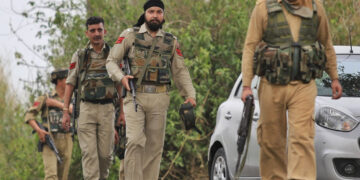
Operation Sindoor: In a decisive military move following the brutal Pahalgam terrorist attack that killed 26 civilians, India launched ‘Operation Sindoor’, a high-precision tri-services operation targeting terror infrastructure deep inside Pakistan and Pakistan-Occupied Kashmir (PoK). The strikes, conducted at 1:44 AM on May 6, 2025, involved coordinated action by the Indian Army, Air Force, and Navy.
Sources confirmed that nine sites associated with terrorist outfits including Lashkar-e-Taiba (LeT), Jaish-e-Mohammed (JeM), and Hizbul Mujahideen were destroyed. These bases were reportedly involved in planning and facilitating terrorist attacks on Indian soil.
According to defense officials, India used SCALP cruise missiles and Hammer Smart Bombs in the operation, marking one of the most technologically advanced missions carried out by the Indian armed forces. “Our actions have been focused, measured, and non-escalatory. No Pakistani military facilities were targeted,” an official statement read.
Symbolic Strike Named for the Widows of Pahalgam Victims
The operation was named ‘Sindoor’—a poignant tribute to the women who lost their husbands in the Pahalgam attack, India’s deadliest since Pulwama in 2019. Among the sites destroyed were terror training camps in Muridke—LeT’s stronghold, and Bahawalpur, the base of JeM.
“Justice is served. Jai Hind,” read a post by the Indian Army on X (formerly Twitter), minutes after the strikes. Defense Minister Rajnath Singh echoed the sentiment, writing “Bharat Mata Ki Jai.”

Targeted Locations & Terror Groups
Sources confirm that Operation Sindoor aimed to dismantle infrastructure used by groups such as Lashkar-e-Taiba (LeT), Jaish-e-Mohammed (JeM), and Hizbul Mujahideen. Key targets included:
-
Muridke – LeT headquarters led by Hafiz Saeed.
-
Bahawalpur – JeM base run by Masood Azhar.
-
Camps near Muzaffarabad, Kotli, and Bhimber Gali in PoK.
Each site had a history of facilitating cross-border terrorism, recruitment, training, and infiltration attempts into Indian territory. The precision of Operation Sindoor ensured these high-risk terror hubs were neutralized without escalating into a broader military conflict.
Weaponry and Strategy
As part of Operation Sindoor, the Indian Air Force deployed SCALP (Storm Shadow) cruise missiles, part of the Rafale jet arsenal, alongside HAMMER smart bombs, ensuring high-precision destruction. The joint operation is considered part of Phase 1 of India’s response, with potential follow-ups based on Pakistan’s reaction.
Pakistan Retaliates With Cross-Border Fire
In response, Pakistan initiated artillery shelling along the Line of Control (LoC) in areas like Poonch and Rajauri, killing three Indian civilians. The Pakistani military also claimed to have downed five Indian aircraft and taken prisoners—claims not independently verified.
Pakistani Prime Minister Shehbaz Sharif called India’s action “an act of war” and vowed retaliation. Heavy shelling has resumed in multiple LoC sectors, leading to panic among civilians and the temporary closure of Srinagar, Jammu, and Amritsar airports. Air India and IndiGo have suspended or diverted flights, while the Indian Air Force is on high alert.
International Response and Diplomatic Moves
The United Nations has urged “maximum restraint”, warning that escalation between the two nuclear-armed nations could have global consequences. US President Donald Trump acknowledged the seriousness of the situation, calling it “a shame” and expressing hope for de-escalation.
As part of India’s carefully calibrated military and diplomatic response under Operation Sindoor, National Security Advisor Ajit Doval has briefed counterparts in the US, UK, Russia, Saudi Arabia, and UAE regarding India’s actions and intentions. Prior to the strike, India had also taken key diplomatic measures—suspending the Indus Waters Treaty, revoking Pakistani visas, and scaling down diplomatic relations.
Operation Sindoor: A Calculated Military Move
Officials indicated that this was Phase 1 of India’s larger strategy to eliminate cross-border terrorism. Each of the nine targets had a history of launching attacks or supporting infiltrators. The selection of non-military targets and precision weaponry highlights India’s intent to avoid civilian casualties while sending a strong message.
Security drills have also been launched across 244 Indian districts in preparation for possible future threats. This is India’s largest national defense exercise since the 1971 war, when Pakistan was divided and Bangladesh was formed.
The strikes have revived comparisons with past actions—such as the 2016 Uri surgical strikes and the 2019 Balakot airstrikes—but Operation Sindoor stands out as the most coordinated tri-service military response in recent history.
Conclusion
India’s response to the Pahalgam attack underlines a significant policy shift—combining diplomacy, military precision, and global communication through Operation Sindoor. While tensions with Pakistan have escalated, India’s stance remains clear: terrorist activities will not go unpunished.
As the situation unfolds, both regional stability and international diplomacy will be tested, with global powers watching closely to prevent further escalation between these long-time adversaries.

















